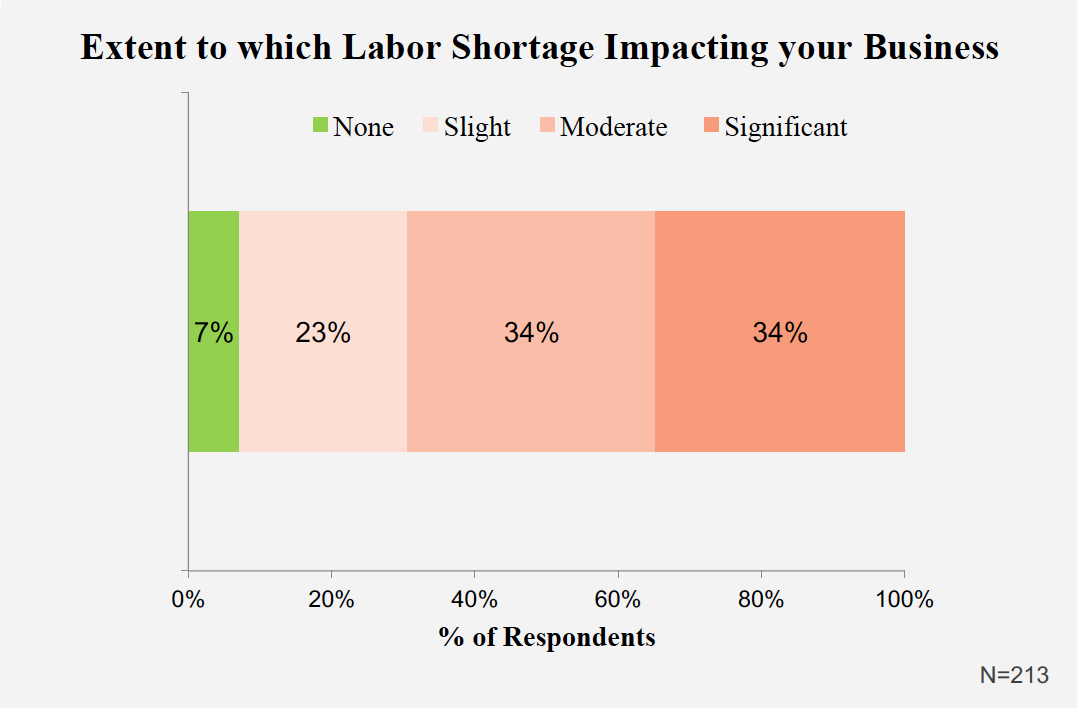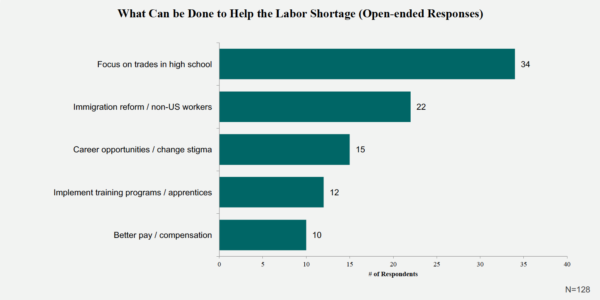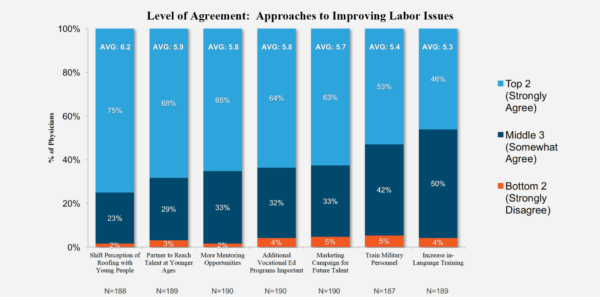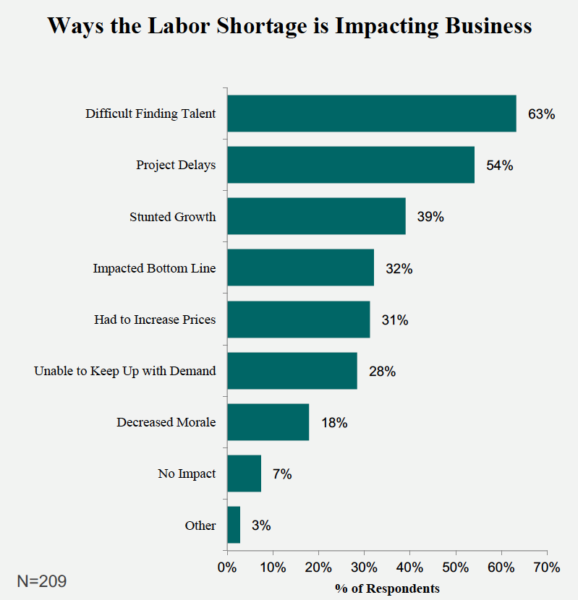When the Job Ladder is an Actual Ladder: 200,000 construction jobs and still no takers

By Don Kilcoyne, GAF.
It seems everybody wants to climb the job ladder, but no one wants to climb a ladder on the job.
First posted in June 2017, this article has been updated with 2018 data including findings from the GAF Contractor Labor Shortage Survey conducted at the 2018 GAF Wealth Builder conference, current industry trends, and recent insights from NRCA CEO Reid Ribble.
In addition, the GAF labor recruitment video, Join the Crew, earned an Emmy award on April 15, 2018 for the GAF Video Production team.
It seems everybody wants to climb the job ladder, but no one wants to climb a ladder on the job.
Right now, roughly 200,000 construction jobs sit unfilled in the United States. The demand for residential homes is far outpacing our capacity to build them. A recent survey by HomeAdvisor lays it out in bleak terms: Of the firms surveyed, 93 percent said they believed the labor shortage is standing in the way of their growth.
Those findings were precisely echoed by the GAF Contractor Labor Shortage Survey, which found only 7% of contractors surveyed reported that the labor shortage was not having any impact on their businesses. The biggest issues identified were finding talent and project delays.
Today, thousands of small businesses from coast to coast are feeling the impact. Of the construction firms participating in the 2018 Construction Outlook Survey, 75 percent predicted a need to expand their headcount in 2018 — up two points from 2017. Unfortunately, “an overwhelming majority – 82 percent – of firms expect it will either become harder, or remain difficult to recruit and hire qualified workers in 2018, up from 76 percent last year.”1
In other words, three out of four of these firms see opportunity on the horizon, but only one in five believe they’ll be able to hire enough professionals to capitalize on it.
The GAF Wealth Builder survey suggests a similar trend. More than two-thirds of responding contractors reported that the labor shortage has had a moderate or significant impact on their business. Difficulty finding talent and project delays were the biggest negative impacts.
Since there are so many more roofing jobs available than crews to install them, it has become, in many ways, a seller’s market for labor.
[Editor’s Note: Brad Corbin is now CEO at HIRevPro LLC. The following comments were made in 2017 in his capacity as President of Excel Roofing.]
Brad Corbin, president of Excel Roofing Systems in Fort Worth, Texas, has watched his competition poach entire roofing crews off of active jobs. “One day they’re working. The next they don’t show up because they were offered a few dollars more per square to do another job,” he said. “The majority of crews you find out there are brand new; some have never installed a roof before. That’s not the kind of crew I want to hire.” The shortage affects not only the number of roofs that get installed, but the type as well. “Subcontractors start picking and choosing what house they want to roof,” said Corbin. “If it’s too steep, they won’t do it. There's plenty of jobs getting done at 4:12 (a gradual 18.5° slope), not at 12:12 (a steep 45°).”
Where have all the workers gone?
There are possibly as many theories about the vanishing labor force as there are jobs waiting to be filled. But labor and industry experts often cite these three factors as driving the phenomenon:
- The Housing Bubble. During the housing crisis of 2006 – 2008, the construction industry lost approximately 40 percent of its workforce to other career paths, and those workers have, for the most part, not returned. Despite steady growth in demand for new houses, there is a lingering perception that construction — and residential construction in particular — is not a stable career choice. Making matters worse, when a million professionals walked away from construction, they took more than their nail guns with them. They took their hard-earned expertise as well.
- Youth Perception. The perceived value of craft careers — and the training they demand — has suffered a dramatic downturn in recent decades. Not only has vocational education funding dried up in schools across the country, but the emphasis on “college for everyone” has created an impression that the trades are somehow less worthy career paths. Despite the popular desire for every young person to earn a college degree, more than 30 percent of American high school students never complete four years of college. That means they enter the job market with neither a college degree nor the skills-based training they need to thrive in construction, manufacturing, or other non-degree careers. And the general dismissal of craft occupations appears to be self-perpetuating. That is, the fewer people we prepare for careers in the trades, the less attractive those careers become. According to a 2017 poll of 2,001 young adults, ages 18 to 25, conducted for the National Association of Home Builders, only three percent of those with career plans saw themselves working in construction. When asked what motivated respondents to choose a career, 76 percent overall said the career was something they were interested in, and 48 percent said it suited their skills and abilities. Could this explain the lack of enthusiasm for craft careers? Can we expect students to dream of using skills that we no longer teach in their schools?
When asked what can be done to help the labor shortage, contractors participating in the GAF Wealth Builder survey most often indicated that focusing on trades in high school would be valuable.
When asked to rate their agreement with ways to improve the labor issues, shifting the perceptions of roofing with young people had the greatest level of agreement among respondents.
- Changing Demographics. As political and law enforcement spotlights burn brightly on the complex challenges of the U.S. immigration policy, one fact remains indisputable: as the Baby Boom generation ages into retirement, new immigrants currently account for all of the growth in the labor force. Research from the National Association of Home Builders indicates that nearly 30 percent of the U.S. construction labor force is foreign-born. For roofers, the number is even higher, at 43 percent. And overall, 53 percent of the immigrant labor force was born in Mexico. Yet immigration (authorized and unauthorized) has slowed significantly in recent years, putting additional stress on employers looking for skilled construction labor.
National challenges demand national solutions
The National Roofing Contractors Association has been confronting these issues aggressively under the leadership of CEO Reid Ribble. As a former roofing contractor and the U.S. Representative from Wisconsin’s 8th District, Ribble has studied the problem from both a professional and policy perspective.
Speaking to the immigration issue, he advocates a practical, economic growth based perspective. “Listening to some of the national rhetoric about immigration,” he said, “some have a tendency to demonize the immigrant who wants to work here. I understand the difference between an undocumented immigrant and one who comes here legally. The latter — the one coming here legally — came here to work. And that’s a good thing. When you consider the sheer demographics, ten thousand American workers are retiring every day. That’s going to continue for the next ten or thirteen years. Along with declining birth rates, that means we have to supplement our workforce with immigrant labor, because there simply will not be enough workers to grow the economy without them.”
He has also made industry perception a key focus of his work, recently concluding a nationwide tour of allied industry groups, trade gatherings such as the International Roofing Expo, and manufacturer conferences like GAF Wealth Builder. His consistent message has been a call to, “reevaluate how we see ourselves. We can’t expect anyone to respect what we do until we respect what we do. As we begin to shift our own attitude on what we do and the importance of our work the marketplace will automatically begin to follow us.”
“Let’s change the way the American people think about roofing,” he said. “Let’s reshape how moms and dads talk about us to their kids.” Older Americans remember roofing as dirty and smelly. “But that’s not today’s roofing industry. Fully one third of commercial roofs are actually white. Very specifically, these are clean roofs!” he said. The public also lacks awareness of the roofing industry’s proud position at the forefront of the sustainability movement, having pioneered zero-waste jobsite policies and developed modern “cool” roofs that are integral to increasing the energy efficiency of the building envelope.
“In order to change the conversation, we have to talk about ourselves differently. We cannot expect others to respect the work we do unless we respect ourselves,” said Ribble. By way of example, he often speaks about the comforts we have come to expect from life in 21st century America. “When you walk into a room and flip a switch, you just expect the lights to go on. When you flush a toilet or turn a tap, you expect the plumbing to respond. And when you call an electrician or a plumber, you look for a certified contractor.”
We expect our roofs to perform, as well, so why don’t we look for master-level certification of our roofers? The roofing industry, said Ribble, needs to increase the perceived value of what we do.
“When it’s storming outside, you expect it to be dry inside. When it’s cold outside, you expect the house to be warm. That professionalism is so ubiquitous that it’s become devalued. We live in comfort without recognizing the skill of the men and women who make it possible.”
To that end, the NCRA is spearheading an effort to establish a nationally recognized professional certification program, with uniform standards, for steep- and low-slope roofers. “Our goal is to be on par with our professional competitors in the other contruction-related fields,” said Ribble. “And we’re decades behind them in this regard.”
This year, Ribble and the NRCA are embarking on a campaign to promote the good things the industry does. Due to the nature of the news cycle, “the only time people hear about roofers is when there’s a fall or an accident,” he said. “People become aware of roofing when there’s a rainstorm and the building leaks, or a snowstorm and the bulding collapses. These rare negative stories capture the minds of the American people.” The facts about roofers, and their proud industry, are less dramatic but far more positive. “Many of our people are roofing the most prestigious buildings in the country,” Ribble continued. “Some of our members are the most philanthropic businesspeople in their communities. We need to begin to tell their stories.” But this is not just a public relations effort, according to Ribble. Instead, it is a mission to elevate the industry — including its own self-perception — to the level it has earned through skill, hard work, and professionalism. “As roofers, we’re a self-effacing, almost self-deprecating group of folks. In many respects, we’re blue collar, believe in working hard, and tend not to talk too much about the good things we do. As a result, the public will see a story about a roofing fire, but won’t hear about the contractor who quietly donates a roof to a church, or puts up four or five roofs to support Habitat for Humanity. Those stories go untold because we are not sharing them. As we begin to tell the positive stories, collectively we will begin to reshape the perception of who we are.”
To catch more fish, cast a wider net
The construction labor shortage appears to have grown out of a complex mix of political, economic, demographic, and educational factors. That means there might be no quick fix. But that’s not stopping manufacturers from doing what they can to help build bridges between underemployed workers and open opportunities.
GAF, the largest roofing manufacturer in North America, for example, is helping connect prospective roofers with its national network of Master Elite® Contractors. This represents a terrific opportunity, on a number of levels, for craftspeople entering the roofing industry. Master Elite® Contractors can be found throughout the United States and Canada, yet only two percent of all roofing contractors have qualified for Master Elite® status. That means each of these prospective employers is properly licensed and insured, has a proven reputation for providing quality roofing services, and has committed to ongoing professional training. New roofers who can find positions with these Master Elite® Contractors are more likely to learn the best roofing practices that lead to satisfied customers and long, successful careers.
The skills and temperament necessary for roofing success can be found in any number of other professions. Thanks to creative outreach and training programs, professionals from all walks of life are discovering fulfilling second careers on the roof.
- Military veterans represent a potentially deep pool of labor that offers a unique fit for the roofing industry. For veterans, a transition to the roofing market offers an opportunity to apply hard-earned skills in a job with excellent growth potential. Roofing suits people who welcome the challenges and rewards of a physically demanding day and offers the opportunity to work with your hands on a team that’s focused on getting the job done. It also offers the chance to earn an above-median salary without taking on higher education debt. To help veterans navigate the transition, GAF has partnered with ProTrain and U.S. Military Pipeline to build GAF Roofing Academy, an eight-day roofing installation training program specifically for veterans. GAF also maintains a Hire A Hero job board specifically to connect veterans with GAF contractors and business partners. Contractors win as well, since both programs save them valuable time sourcing and qualifying job candidates who have already distinguished themselves for character, dedication, and work ethic.
- Oil and gas workers have made the shift to roofing due to fluctuations in the energy market. As Corbin described it, “The oil field really dumped on some of these guys.” Roofing has given some a chance to work closer to their own community, develop a local network, and put down roots in a way the energy industry may not support.
- Even some white collar professionals have traded staplers for nail guns. In fact, the demand for workers has attracted professionals from a wide range of specialties. Corbin said he seeks out pros from different industries because they bring a broader understanding of business, and are not burdened with the bad habits often associated with fly-by-night contractors. “I have an electrician as purchasing manager, a pharmaceutical sales guy as a sales person, and an internet director as a sales manager. We are trying to raise the standards, raise the expectations of our customers,” he said.
Making a successful transition to the roofing business takes some training and mentorship. The GAF-sponsored CARE (Center for the Advancement of Roofing Excellence) program offers professional educational programs to the roofing industry. More than 230,000 professionals in the USA, Canada, and Mexico have attended CARE courses, including a lot of the guys on Brad Corbin’s Excel Roofing team. “I’m striving to get all my guys steep-slope educated,” he said. “I won’t let anyone become a salesman until they know steep-slope.”
Loyalty pays off — for everyone
His commitment to raising the standard has helped Corbin avoid the worst of the labor crunch. In fact, he sometimes finds himself providing spare crews to other roofing contractors. “I don’t like to do it. That’s how crews get poached. But we always want our people working.” Although he’s able to deploy up to 23 crews on a given day, Corbin said there’s no secret to how he attracts and motivates roofers while others are turning down work. “We treat everyone like a team mate, even when they’re a subcontractor,” he said. “If they’re on our roofs, they’re our men, they’re on the Excel team. I have a production supervisor on every job, working alongside the crew, and that promotes a team atmosphere.” That philosophy extends to all areas of the business. “Loyalty goes a long way, whether you’re a roofing contractor, a distributor, or a manufacturer. I respect the partnership, because frankly, we’d be out of business without our crews.”
Reid Ribble concurred. “Part of the challenge is putting a human face on what we do,” he said. “It’s all about the people.”
Getting the message out
The current labor shortage is not a short-term glitch and won’t be solved with a specific program or campaign. Training programs like those run by GAF can help, as will elevating the professional standards expected of roofing crews, as championed by the NRCA.
But right now, awareness is key. To that end, GAF has launched a Join the Crew campaign, to reach out to the next generation of roofers. The campaign focuses on a message of opportunity to build a secure future, and leverages important messages of pride, good pay and teamwork. To help get the message out, GAF has developed a customizable video, available to contractors, to help them communicate their hiring opportunities.
Jim Schnepper, president of GAF, has been an enthusiastic advocate for roofing industry recruitment. “Roofing lies at the very center of so many issues that will impact not only our futures, but the futures of our children and grandchildren,” he said. “From our sustainability initiatives to residential solar, and from cool roof technology to disaster response, this industry is leading the way toward a greener, more responsible tomorrow. Every roofer who protects a home, church, school or business with modern roofing materials should be proud of the positive impact they are having on our environment and economy. Now, our challenge is to focus that well-earned pride on the task of recruiting more roofers.”
Skilled, underemployed craftspeople need to be made aware that good-paying, steady work is waiting for them. The next step on their career ladder is a rung on an actual ladder. And from up there, the sky is, literally, the limit.
Learn more about GAF at www.gaf.com.
Editor’s note: This first published on the GAF Blog.






-2025-xtv-mls-tour-2.png)


















Comments
Leave a Reply
Have an account? Login to leave a comment!
Sign In